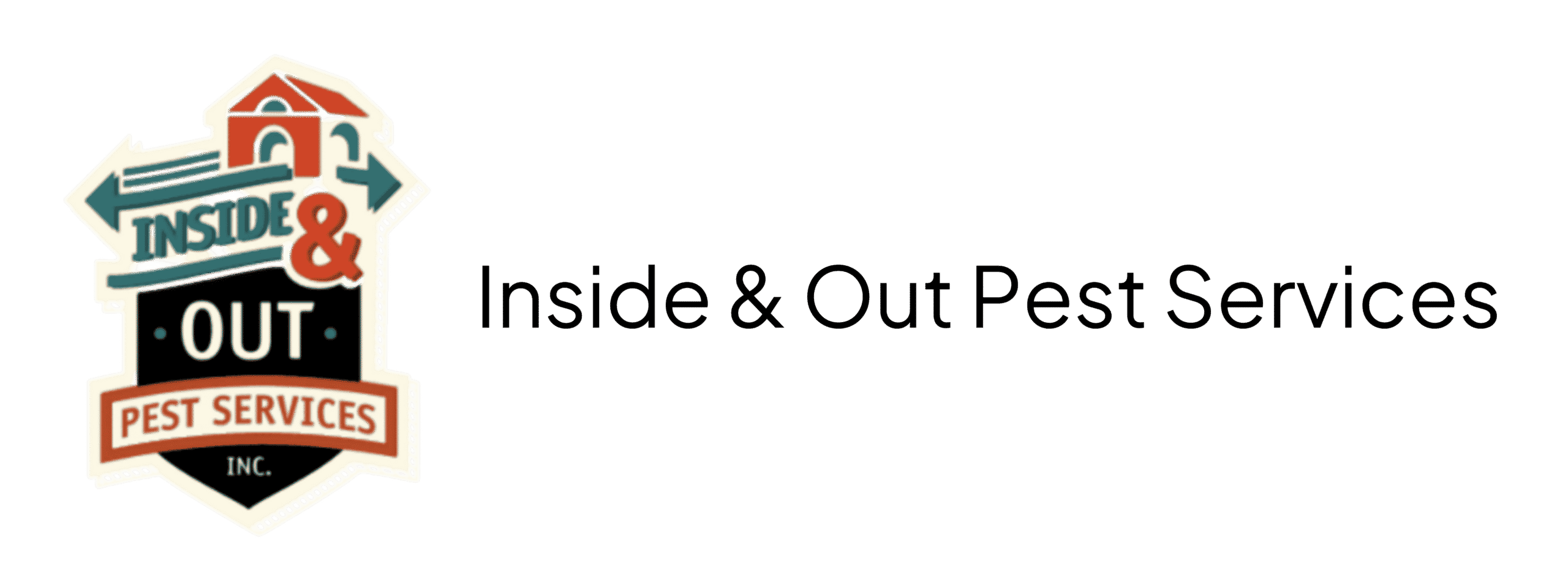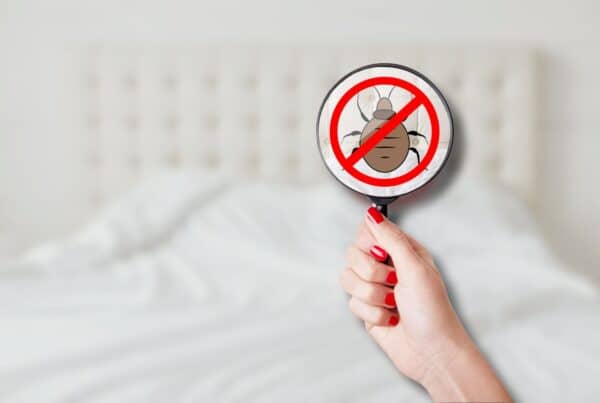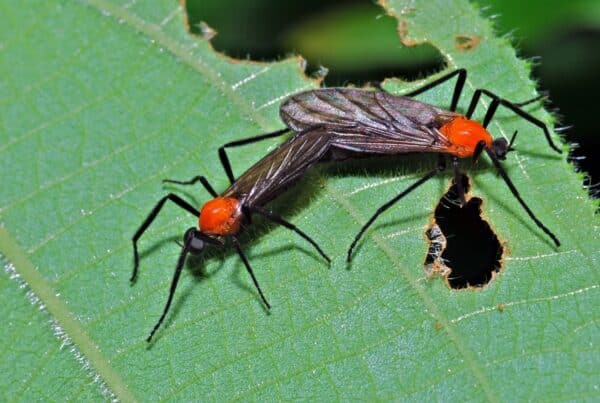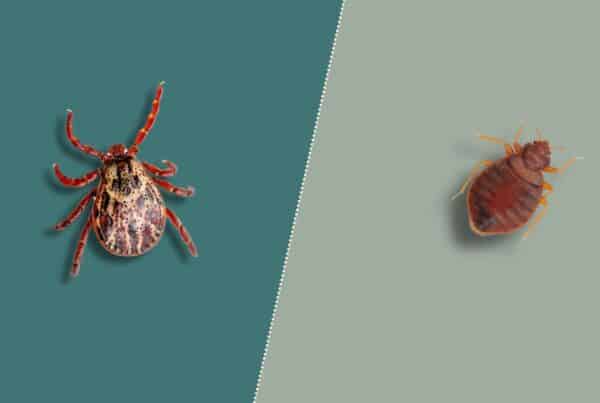While wasps have an important place in the Florida ecosystem, their painful stings and large nests around homes can make them a nuisance. The key to coexisting is understanding which species you’re dealing with. Some are docile plant pollinators, while others will aggressively defend their territory.
In this post, you’ll learn how to identify the five most common wasps found buzzing around local neighborhoods. With details on their appearance, nesting habits, and temperaments, you’ll know when to leave a nest alone, and when it’s best to call in pest control.

Paper Wasps
Firstly, with their slender, golden-yellow bodies and rusty-red wings, paper wasps are a common sight fluttering through Florida gardens. They build open, umbrella-shaped nests made from chewed wood pulp, earning them the name “paper” wasps.
These wasps have slender bodies about half an inch long and wings that are folded lengthwise when resting. Their legs dangle in flight and they are more slender than other wasps. Paper wasp nests contain up to 200 cells and are built under eaves, in shrubs, or on tree branches.
While they can sting, paper wasps tend to be docile and less aggressive. They prefer hunting caterpillars and other garden pests rather than picnicking humans. Their presence around the yard helps control pest populations. However, nests around doorways or play areas for kids could warrant removal by a professional to prevent stings.

Yellow Jackets
The bold yellow and black stripes of yellow jackets make them easily recognizable in Florida. These short-tempered wasps will aggressively defend their nests which are often found underground or in wall voids.
Yellow jackets have a distinct hovering flight pattern and grow up to half an inch long. They can be identified by their bright yellow and black bands, as well as a black dot on their abdomens. Nests contain up to 4000 wasps and are built underground using chewed wood fibers.
While other wasps feed on nectar, yellow jackets are carnivores and scavengers. They swarm picnic tables, soda cans, and trash cans in search of sugary snacks and protein. Yellow jacket nests near high-traffic areas pose a safety risk due to their aggressive stinging in defense of the colony. Multiple stings can be medically dangerous. Keep a lookout for these pushy Florida wasps around playgrounds, hiking trails, campsites, and backyards!

Red Wasps
The fiery red bodies and wings of these wasps make them stand out as they dart around Florida landscapes. Red wasps are a solitary species and can be beneficial pest controllers when nesting alone.
At up to 1 inch long, red wasps are slightly larger than yellow jackets. Their abdomens are a burnt orangey-red color with some yellow markings. They build small paper nests in trees, shrubs, and under eaves. Red wasps hunt caterpillars, flies and spiders to feed their larvae.
While they pack a painful sting, red wasps tend to mind their own business when undisturbed. However, nests near entryways or in playgrounds could warrant removal before their defensive instincts kick in. Observe nests from a distance.
Their presence helps control garden and crop pests. Their bold colors may give them a fiery reputation, but a little space can allow peaceful coexistence.

Mud Daubers
Known for their quiet disposition and unique mud nests, mud daubers are solitary wasps that peacefully inhabit gardens across Florida. They can be identified by their long, thin waists, dark blue metallic bodies, and long legs with a hunched stance.
Mud daubers build nests from mud, which resemble organ pipes or mud tubes attached to walls and eaves. Their nests contain several cells where they stash paralyzed spiders and other insects for their larvae to feed on. While they can sting, mud daubers are quite docile and rarely bother humans. They tend to avoid confrontation in favor of hunting spiders and building their mud nests. Their presence can help reduce black widow and brown recluse populations.
Appreciate their artistic nests and pest control services from a distance. Mud dauber nests on porches or doorways can be gently removed and relocated. However, in most cases, peaceful coexistence with these mild-mannered wasps is easily achievable.

Bald-Faced Hornets
With their large, white-marked nests and aggressive defense, bald-faced hornets are a common nuisance around homes in Florida. While useful for pest control, their painful stings warrant keeping a safe distance.
Bald-faced hornets have black and white bands across their abdomens, and white faces, and grow up to 1/2 inch long. They build football-sized nests in trees, under eaves, and other sheltered spots, using chewed wood pulp. Nests contain up to 700 members who aggressively defend the colony.
Hornets prey on flies, caterpillars, and other pests, making them beneficial. However, they will vigorously sting anything perceiving it as a threat. Multiple stings can quickly become medically dangerous. Nest removal is a job for trained professionals. Watch for these sizable nests around your home and yard. Bald-faced hornets will let you know if you get too close.
Prevention and Recommended Maintenance
Some species of wasps are docile, but prevention is key to avoiding stings and nests on your property. To avoid any run-ins, consider a few simple ways to discourage wasps around your home:
- Keep the yard free of piles of mulch, stones, and debris that provide nesting sites. Clear away old nests and prune back vegetation.
- Maintain a clean home exterior by sealing cracks, repairing screens, and caulking wall gaps. Eliminating entry points and shelter for nests is crucial.
- Remove food sources like exposed garbage, pet food, and ripe fruit that attract insects like wasps. Use lidded trash cans and keep pet bowls inside.
- Finally, install nesting boxes for insect-eating birds like chickadees. Their presence helps naturally deter wasps.
When to Call a Professional
While maintaining a safe distance from docile wasp species is best, some nests warrant contacting a professional ASAP. Here are some scenarios that call for expert removal:
- Large underground yellow jackets nest near high-traffic areas like patios, doorways, and playgrounds. Their aggressive defense poses serious stinging risks.
- Sizable bald-faced hornet nests in trees or under eaves that are difficult to avoid disturbing. Multiple stings from defending hornets can quickly become medically hazardous.
- Wasp nests inside wall voids that you can hear buzzing but cannot locate. Attempting removal could dangerously agitate them. Professionals can track nests and strategically eliminate them.
- Nests near sensitive individuals like those allergic to stings. Professionals have protective equipment to safely eliminate the nest.
- Persistent reappearance of nests each season. A pro can find and seal entry points after removal to prevent re-infestation.
Wrapping Up
Our ecosystems benefit greatly from the presence of wasps, but some species are better admired from a distance. Now that you can identify paper wasps, yellow jackets, red wasps, mud daubers, and bald-faced hornets, you’ll know which require removal and which to simply let be.
With a little yard maintenance, prevention methods, and selective professional help for nest removal, we can minimize unwanted encounters. To get help addressing existing wasps near your home or to schedule preventative services, don’t hesitate to reach out to the experts with Inside and Out Pest Control in Jacksonville, FL, and surrounding areas.



